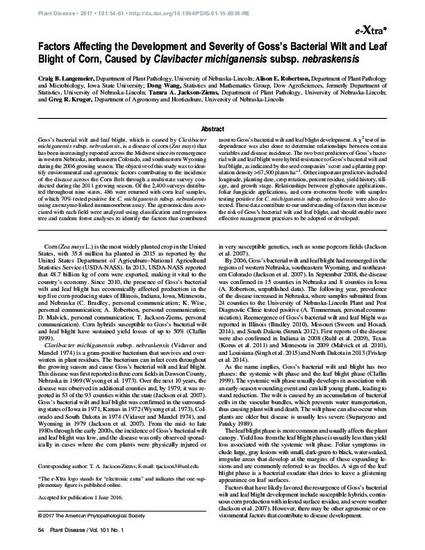
Goss’s bacterial wilt and leaf blight, which is caused by Clavibacter michiganensis subsp. nebraskensis, is a disease of corn (Zea mays) that has been increasingly reported across the Midwest since its reemergence in western Nebraska, northeastern Colorado, and southeastern Wyoming during the 2006 growing season. The objective of this study was to identify environmental and agronomic factors contributing to the incidence of the disease across the Corn Belt through a multistate survey conducted during the 2011 growing season. Of the 2,400 surveys distributed throughout nine states, 486 were returned with corn leaf samples, of which 70% tested positive for C. michiganensis subsp. nebraskensisusing an enzyme-linked immunosorbent assay. The agronomic data associated with each field were analyzed using classification and regression tree and random forest analyses to identify the factors that contributed most to Goss’s bacterial wilt and leaf blight development. A χ2 test of independence was also done to determine relationships between certain variables and disease incidence. The two best predictors of Goss’s bacterial wilt and leaf blight were hybrid resistance to Goss’s bacterial wilt and leaf blight, as indicated by the seed companies’ score and a planting population density >67,500 plants ha−1. Other important predictors included longitude, planting date, crop rotation, percent residue, yield history, tillage, and growth stage. Relationships between glyphosate applications, foliar fungicide applications, and corn rootworm beetle with samples testing positive for C. michiganensis subsp. nebraskensis were also detected. These data contribute to our understanding of factors that increase the risk of Goss’s bacterial wilt and leaf blight, and should enable more effective management practices to be adopted or developed.
Available at: http://works.bepress.com/alison-robertson/249/

This article is published as Langemeier, Craig B., Alison E. Robertson, Dong Wang, Tamra A. Jackson-Ziems, and Greg R. Kruger. "Factors Affecting the Development and Severity of Goss’s Bacterial Wilt and Leaf Blight of Corn, Caused by Clavibacter michiganensis subsp. nebraskensis." Plant disease 101, no. 1 (2017): 54-61. doi: 10.1094/PDIS-01-15-0038-RE. Posted with permission.